John D. Rateliff's Blog, page 47
February 18, 2021
C. S. Lewis Biopic in the works
So, it seems a film biography of C. S. Lewis is now in the works, scheduled for a release late this year (or so they hope).
Called THE MOST RELUCTANT CONVERT, a phrase taken from CSL's autobiography, it's directed by the same director who did the Joss Ackland SHADOWLAND years ago. The story is said to be based on Max McLean's one-man show, which we've seen. The structure however sounds quite different, with three different actors portraying CSL at different times in his life, the older Lewis sometimes commenting on the younger. If done well this might recapture the feeling of its being Lewis's autobiography, where he repeatedly contrasts the himself of the present day with his earlier, starkly different younger selves.
The one article I've seen says almost nothing about the supporting cast (e.g., is Janie Moore given due prominence? what about his brother Warnie?) but it does specify that JRRT will be a character (played by one Tom Glenister), described as "one of his [Lewis's] intellectual sparring partners".
They apparently did some on-location filming in Oxford. It'll be nice to see the Kilns and Magdalen.
Thanks to David B. for the link, which I found in his post on the MythSoc list.
--John R.
February 14, 2021
A Report on my Glasgow talk
So,
one more follow-up on my Glasgow talk, in the form of a report on the Centre's blog from one attendee about how it went, plus a reading list of works, some referred to in my talk but for the most part generated in the Q&A and Chat that followed.
I'm glad to say that the verdict is that the presentation went well --though looking over all that was going on at the same time in parallel in the audience response as I was speaking makes me wish my responses were more focused.
Here's the link:
Many thanks to Grace and Emma and Hannah and of course Dimitra for all their hard work putting this event, et al, together.
--JDR
Old TSR Boardgames (KNIGHTS OF CAMELOT)
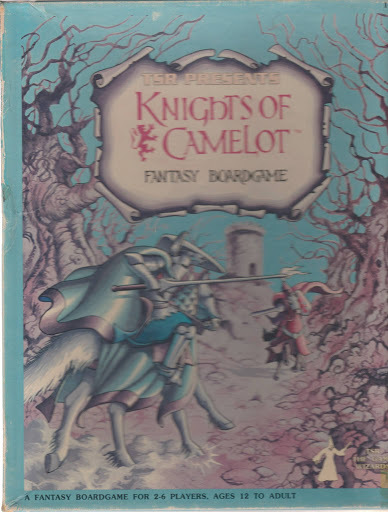
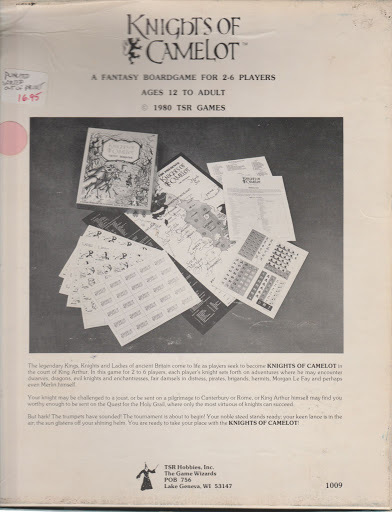
So, the next game (product #1009) on the shelf is somewhat later (1980) and more appealing in its art and components, with an attractive cover and pleasant color pallet for both box and map. Written by the Rahmans, this is a much more substantial work than, say COHORTS of WARLOCKS & WARRIORS, with a thirty-six page rulebook, poster-sized map, encounters sheet, dice, chits, and cards.
This was another purchase from Crazy Igor, apparently a Christmas present to myself since I got it December 21st 1993 (a Tuesday). In all the time since I've only played this game once, some years back, when Steve Winter ran it for several of us who'd never played and were curious. I remember I was underwhelmed, but I don't remember why.
Similarly I know there were two editions of this game, not sure why. Maybe I'll see if I can run through a solo game before it goes out the door. It might be fun to see how well it might match with PENDRAGON. I do see from BoardGameGeek that there's a DRAGON magazine article offering rules on how to play a varlet rather than a chivalrous knight,* which again sounds worth checking out.
One final feature of note is that the map is credited to Darlene Pekul and the cover art to "Eymoth and Erol Otus". Eymoth I haven't come across before. Otus by contrast is one of the most distinctive artists TSR ever employed. I have to say though that the cover art for this game is unusually subdued by his standards and I wdn't have recognized it as his work.
Next up: something completely different (SNIT'S REVENGE).
--John R.
--current reading: TEHANU, TOLKIEN'S MODERN READING, light novels.
*"Being a Bad Knight" by Glenn Rahman, DRAGON #58 (Feb 1982)
February 12, 2021
Old TSR Boardgames (WARLOCKS & WARRIORS)
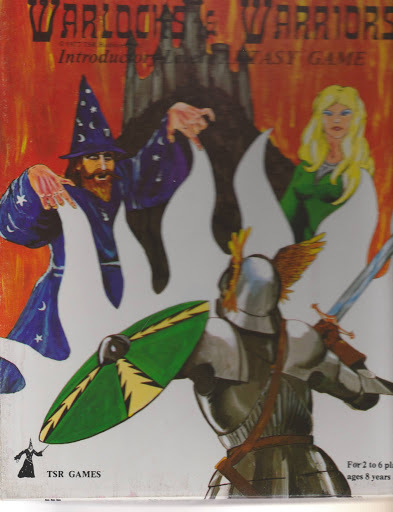
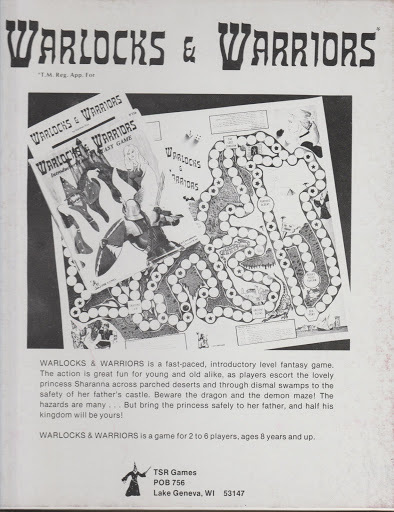
So, to resume.
As my Marie Kondo deathmarch through my shelf-full of early TSR boardgames I've had for years and for the most part never played continues, we come to WARLOCKS & WARRIORS (1977), product #1003.
This turns out to be yet another of TSR's confusing array of intro-level games (this one retooling the target audience down to age 8 & up), with this particular entry complicating that tangled history just a little more.
It also turns out to be another of the games designed by fantasy authors Gygax liked (the 'Famous Authors' or 'Famous Writers' Series), like de Camp's COHORTS and, presumably, Leiber & Fischer's LANKHMAR .
In this case the sword and sorcery writer in question was Gardner Fox--who though remembered today primarily as a third-rate Conan imitator* was clearly a favorite of E. Gary G.**
The basic idea underlying this game is paring down the character classes to just two: Warlock (magic-users) and Warrior (fighter). The best thing about it, looking back from the present day, is the Dave Sutherland art, which is reminiscent of the art towards the end of the DMG depicting an adventuring group's up and downs in their explorations.
As for the game itself, the puzzle is why did they need this when they had Megarry's DUNGEON (which is in fact advertised on the last page of WARLOCKS & WARRIORS' rulesheet)?
Just as an aside, I shd record that my copy was a gift from Slade Henson (June 7th 1994). Slade was at that time downsizing his own collection. It's perhaps amusing to note that Slade credited his having such a nice collection to his having arrived in Lake Geneva to start work at TSR (circa 1989?) on the same weekend that Frank Mentzer had a big garage sale . . .
--John R.
--current reading: light novel, Ordway's book, TEHANU
*Fox's main claim to fame are not his fiction but his work in comic books: he played a major role in the creation and scripting of ADAM STRANGE.
**The full credits read
Game Design: Gardner Fox
Development: Brian Blume & James Ward
Graphics: David Sutherland, Brian Blume & Gardner Fox
UPDATE: FAMOUS AUTHORS SERIES
I shd have included in the post above information from Zenopus's comment on my earlier post re. COHORTS: Roman Checkers. It is clear from Z's additional researches that the three works so listed as belonging to this series are
(1) LANKHMAR [Fischer & Leiber]
(2) WARLOCKS & WARRIORS [Fox]
(3) COHORTS [de Camp]
Thanks to Zenopus A. for clarifying this.
February 9, 2021
The Text of My Glasgow Talk
So, just wanted to share the link to this, the script of my Glasgow talk, 'Giants in the Oerth'. This version shd be handy for anyone who may want to cite it, or if there are those who prefer text over audio/video.
Plus, this time with endnotes.
And in the interests of fixing a small misstep, I now realize that when I said Moldvay did the 'Giants in the Oerth' column the assistance of Schick, it wd have been more accurate to say the two did it as partners.
Here's the link. Thanks again all for the questions and comments.
--John R.
February 6, 2021
Old TSR Boardgames (4th DIMENSION)

So, this one is a bit of an odd man out, being the American adaptation / edition of a previously published English (UK) game. It'd be nice to be able to say that this game about Time Lords was connected in some way with DOCTOR WHO, but no such luck. Instead this is a positional game all about positioning your markers most advantageously; it has echoes of Stratego and Chess
And that's really about it. Perhaps the design has appeal that's not apparent from just skimming the rules and setting up the pieces. Unfortunately none comes across in the two online play-throughs I found on YouTube / Boardgame Geeks. It also has the problem that the gamepieces look too much alike and the board is too small.
One mildly shocking feature of the game is its naming one standard type of move a "suicide". There's an unfortunate bit of word choice that wd never see the light of day today.
The games' product number/stock number is #5004; it's also a bit later (1979) than the other games I've been looking at in this string of posts.
In the end, I get the sense that this game functions better as a piece of set design in, say, an old episode of STAR TREK than being something someone wd actually want to play. Pity.
--John R.
February 5, 2021
Old TSR Boardgames (BATTLE OF THE FIVE ARMIES)
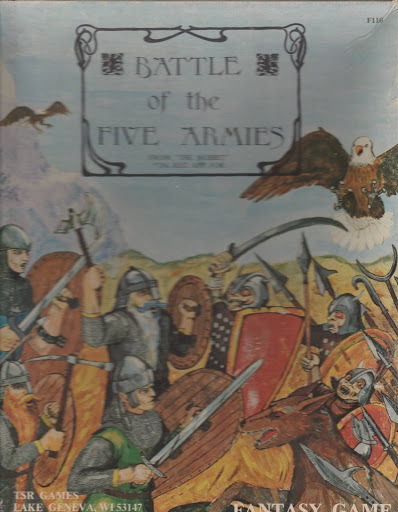
So, this might be known as The One That Got TSR in Trouble, were there not competition for that title (cf. WARRIORS OF MARS). Gygax tells the story in anecdotal fashion:
TSR was served with papers threatening damages to the tune of half a mil
by the Saul Zantes (sp?) division of Elan Merchandising on behalf of
the tolkien Estate. The main objection was to the boardgame we were
publishing, The Battle of Five Armies. The author of that game had given
us a letter from his attorney claiming the work was grandfathered
because it was published after the copyrights for JRRT's works
had lapsed and before any renewals were made. The action also
demanded we remove balrog, dragon, elf, ent, goblin, hobbit,
orc, and warg from the D&D game. Although only balrog and
warg were unique names we agreed to hobbit as well, kept the rest,
of course. The boardgame was dumped, and thus the suit was
settled out of court at that.
—CHEERS, GARY (circa 2002) p. 108
Since it'd take a whole separate post if not more to unpack and fact-check Gygax's account (e.g., Zaentz's 'Tolkien Enterprises' did not represent the Tolkien Estate, though they often found it useful to give the impression that they did), and because I've written about this boardgame elsewhere, all I'll say about it here is that my favorite rule can be found at the bottom of page 5 of the rulebook:
SMAUG VS THE DWARVES
. . . For this scenario Smaug may only be killed by Bowfire. Note: In this scenario the Dwarves have no Bows.
--Think over that one for a bit. Kobayashi Maru, anyone?
Maintaining their confusing tradition in assigning stock/product numbers, this game is #F110
--that is, the tenth in their line of boardgames, this time tagged as a Fantasy title.
On a personal note, while I'm vague on exactly when I got most of the games I'm covering in their sequence of blog posts, this one I can be specific on: I got it at Origins in 1995 (Sunday July 16th), that being the only time I ever went to Origins. It cost me $18.95, probably because all the pieces have been punched and ziplock bagged. Finally, I bought it from Crazy Egor -- not just his booth but Crazy Egor himself. *
--John R.
--current reading: three Japanese light novel (the equivalent of young adult fiction).
*I also bought the original boxed set of Chaosium's MASKS OF NYARLATHOTEP at the same time and place, but it cost me $29.95. It was worth it. And now, all these years later, I'm coming to the end of playing the adventure.
February 4, 2021
Old TSR Boardgames (COHORTS : Roman Checkers)
So, another of TSR's early boardgames is more significant for its associations than its gameplay. Published by TSR under the name COHORTS: THE GAME OF ROMAN CHECKERS,* it's a reconstruction of an ancient game, the rules for which are lost. The game has different names in different cultures. From a quick survey I suspect some of these are different games now associated together more than is perhaps justified.
More interesting than the game itself is the fact that it was the work of L. Sprague de Camp. At first de Camp seemed an odd choice to create (or re-create) a boardgame. Then it hit me: one of de Camp's most famous works is his LEST DARKNESS FALL (1939), a Connecticut Yankee novel about a modern-day engineer who finds himself back in Late Antiquity Rome. If we consider de Camp, who was something of a polymath, an expert in all things Roman, his authoring a Roman or pseudoRoman game makes more sense.**
de Camp's name appears at the end of the rulesheet and on one of the box sides, which says
COHORTS, THE GAME OF ROMAN CHECKERS,
has been specially prepared by world famous author L. Sprague de Camp.
The box bottom reads
COHORTS is the third title in TSR's "Famous Writers Series", and this edition of the game was prepared by noted writer L. Sprague de Camp.
The phrase "Famous Author Series" appears in a starburst in the upper right corner of the boxtop.
So, what is the Famous Writers/Authors Series, and what are the other entries in it (presumably at least two, if this is the third one)? I assume the Leiber/Fischer LANKHMAR Game was one, and that the Larry Smith version of Tolkien's BATTLE OF FIVE ARMIES the other.
Finally, for those trying to sort out the seqyence, this game's stock number is #5002.
--John R.
--New Arrival: Holly Ordway's long awaited TOLKIEN'S MODERN READING.
*Thanks to Steve Brown for my copy of this.
**This was not de Camp's only contact with TSR: DRAGON MAGAZINE reprinted one of the Harold Shea 'Incomplete Enchanter' stories.
February 3, 2021
Lankhmar Lore --found
So, thanks to Jeff G's comment on my previous Lankhmar post, I now know where a lot of the questions I had can be answered. Jeff pointed me towards a string of articles about the LANKHMAR Game that had appeared in DRAGON Magazine in late 1979/early 1980.
In all there were seven pieces in this series, all of them written by Dr. Frederick MacKnight:*
DRAGON #30. p.16-17 (Oct 1979)
DRAGON #31. p.32-34 (Nov 1979)
DRAGON #33. p.12-15 (Jan 1980)
DRAGON #34. p.32-33 (Feb 1980)
DRAGON #36. p.46-47 (Apr 19800
DRAGON #37. p.31-32 (May 1980)
DRAGON #38. p.44-45 (June 1980)
MacKnight's claim to fame is that he was the person who introduced Fischer to Leiber. He also played the original version with Fischer and Leiber and can (and does) describe it in exhaustive detail. Unfortunately he rather confusingly describes and discusses the original game ('LANKMAR'), the new game ('LANKHMAR'), and his own proposed re-design of many features of both. Here's what MacKnight has to say (emphasis mine):
I am one of the few people ever to have played the original game of Lankhmar
other than its original authors, Harry Fischer, Fritz Leiber, and Martha Fischer.
There was also Prof. Lawrence (Larry) Howe of the University of Louisville,
and that is all. Harry owned the board and hadn't had many games-minded
friends since college days.
Perhaps the most interesting thing here is learning that Martha Fischer played a crucial role. Indeed, she created the map board, which had a 3D element to its terrain. MacKnight says he was Ningauble and suggests that Martha F. was Sheelba (Leiber and Fischer were Fafhrd and The Mouser, of course). And apparently there was a good deal of roleplaying when the characters came into conflict.
Playing the game took a major time investment of several days --at least a weekend. But in MacKnight's opinion it was more than worth it:
I played the game only three or four times but it was enough to convince me
that it was the greatest, most fascinating game ever invented by man.
In addition, we learn some worthwhile misc. facts:
That the board was six feet tall and three feet wide.
That the map was oriented North / South, unlike TSR's East / West, which had created blank areas that Gygax et al had filled with inserted place-names of their own devising.
Each square was 1&1/2 inches across.
The landbridge was twice as wide in the original.
As for the War Cat, MacKnight sheds light on this when he groups it with mounts:
The beasts are horses and camels. In [the original game] these were represented
by checkers: black for horses, red for camels. There was also the War Cat,
represented by a furry button. In [the new game] the War Cat plays no
active role. He must be too old now too leave his lair!
I admit to being curious whether the original survives and if so where it is now. We know the board was in Fischer's keeping, and that it must have survived intact down to the mid-1970s, when Gygax et al must have borrowed it to work from when creating their stripped down version. The chief reason given by Gygax for not publishing the original game as is was simply cost: the game wd have to be priced at fifty to a hundred dollars, in a day when the EMPIRE OF THE PETAL THRONE box was considered extravagantly expensive at twenty-five dollars.
Nowdays, of course, things are different. A deluxe Kickstarter might well have a good chance of getting funded, assuming the original survives to serve as the template.
--John R.
*MacKnight's first name is given variously as Franklin and Frederick; I'm not sure which is right.
Coda: Fafhrd's Dilemma
Before moving on, I wanted to mention the seventh and last of the pieces MacKnight inflicted on DUNGEON editor Tim Kask, which was unlike the rest in that it was a logic puzzle. Here's a quick summary:
Fafhrd is in a death trap.
The Gray Mouser has five minutes to disable the trap and free him.
The person to whom the puzzle is posed asks questions
to create the scene and reveal what to do to save his partner.
--JDR
February 2, 2021
Lankhmar Lore
So, I took a look at the LANKHMAR map, cards, tokens, and rulebook in hopes that this might turn up some Lankhmar lore—details about Leiber & Fischer's world from early after its creation that might not have made it into the fiction. There turns out to be very little of this, though what's there is intriguing (see below). The biggest change is in accepting that the Gray Mouser and Fafhrd are here just two of four co-equal heroes (each being one player's character), the other two being Pulgh of Lankhmar and Movarl of Kvaach Nar. Fafhrd leads a Mingol army while The Mouser fights on behalf of the Chosen of the King of Kings (a figure wholly unknown to me).
Now that I've looked through the rules, I'd say the game play must be fairly chaotic,* since there are multiple elements that disrupt each player's plans. The most amusing of these are the GEAS cards. Each player has to draw one of these at the start of each turn, and they represent quests that either Sheelba or Nignauble force that player to go on. That hero has to either temporarily abandon the war and take on the geas himself or delegate it to one of his minions. Typical Geases include
• "Go to the Trollstep Mountains to learn the trollstep dance and report back to Sheelba"
• "Go to the City of Ghouls and bring back a Ghoul-friend for Ningauble"
and my personal favorite:
• "Find an earthworm from Earth's End and bring it to Sheelba".
Sometimes Sheelba will lend her boat to help out a hero, Sheelba's boat being another new element.
The typical reward for fulfilling a GEAS is to be free of it, but sometimes there's a Reward, with effects detailed on the REWARD card.
The most interesting of these involve an elusive character known as the War Cat, who appears on two of the cards. The War Cat gives out gifts to heroes, but there's no clue of what he, or she, or It might be, though we do know that it lives in a cave (the Cave of the War Cat) on the far west of the map.*
1st card. "Go to the Cave of the War Cat and gain your choice of a sword, spear, axe, or bow and arrow"
2nd card. "The War Cat gives you aid in combat: Add +1 to the die roll of the man of your choice (hold until used). Discard when used."
So, who or what is the War Cat? In the absence of any other evidence I'd have assumed something along the lines of the Cath Paluc. But in the game it functions as a sort of minor Sheelba/Ningauble --less perilous to approach, distributing lesser reward. The parallel between the names Gray Mouser and War Cat makes me think the Cat is a who, not a what. That visitors are given weapons suggests faint echoes of Scathach, but that's probably pushing it.
Unless of course it's just something Gygax or one of the other mid-seventies re-casters of the game put it in as some kind of private joke.
Perhaps someday we'll get a book-length study of Leiber that'll answer questions like these.
--John R.
*one good example of this is the Sunken Lands, a land-bridge that submerges at unpredictable intervals, possibly drowning an army crossing the land-bridge at the time.
John D. Rateliff's Blog
- John D. Rateliff's profile
- 38 followers



